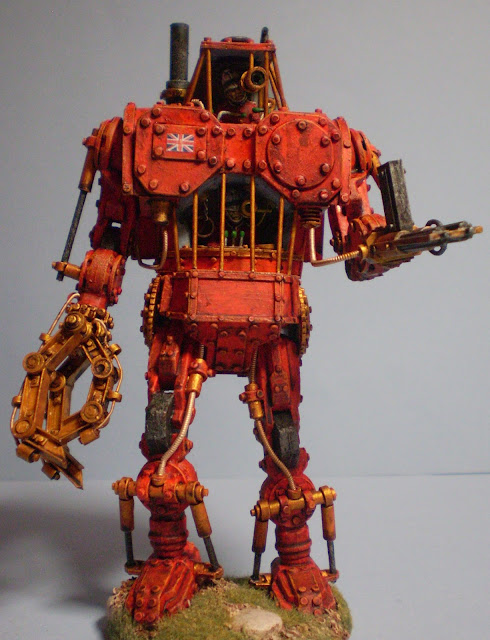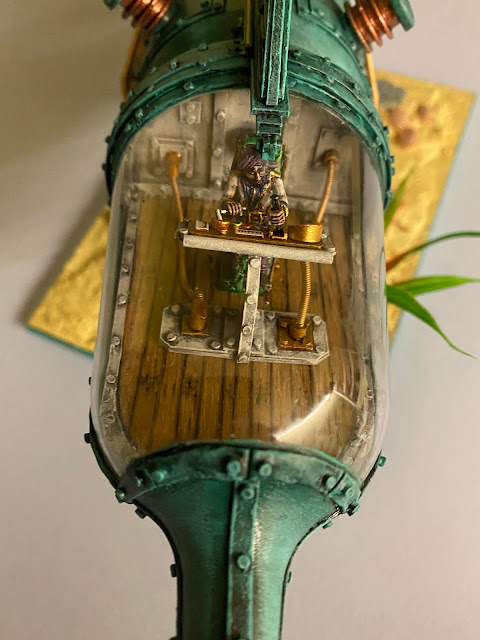Hi, All!
 |
| Coming atcha from the depths of me 'obby room... |
Once again I find myself writing to you after something of a long break, but here I am... hale and hearty with many a rivet!
I recently received a commission to build my version of The Nautilus from Jules Verne's 20,000 Leagues Under The Sea. "Hmmm..." I thunk, "Sounds like the ideal opportunity to build my version of Jules Verne's 20,000 Leagues Under The Sea!"
And so, with a song in my heart, a snorkel in my mouth and glue on my fingers, I set about building my version of The Nautilus from Jules Verne's 20,000 Leagues Under The Sea...
 |
| Old test pots, a cotton bobbin and a heat sink form the beginnings of the vessel. |
In the time since my last post, not only had I not done much model making, but I had also moved house and set up a new hobby room. Consequently, I had lost track of what bits and pieces I had. So began an epic rummaging session, aided by two kittens. The results... paint pots, a plastic wine glass, cogs, guitar strings, a cotton bobbin, garden irrigation components and a heat sink from a light fitting.
 |
| Cardboard panels, irrigation bits and some nuts are added... |
The basic structure of the vessel was the easy part. I wanted something a bit more interesting than just a tube, but being a submarine, the model needed to look streamlined. I very quickly glued together a few components to give me a starting point, and then started adding details.
 |
Captain Nemo is created in his chair using bits from plastic soldiers, lots of Greenstuff, plastic board and an old cog.
|
 |
The basic bridge is tested for it inside the wine glass.
|
 |
Details are added and the first rivets are placed!
|
A vessel is nothing without its captain, so I decided early on that I would be including Captain Nemo, and that this would necessitate a clear canopy of some kind, along with a detailed interior. Fortunately for me, I had some plastic wine glasses whose diameter was a perfect match for the paint pots!
I started Nemo off with a plush-looking chair for comfort and built him up from there using bits from a plastic Mahdist (Perry Miniatures) a British Line Infantryman (Black Powder Miniatures) and lots of Greenstuff. I also built him a control panel, into which the rods I had him holding would neatly fit when everything was ready.
Then I turned my attention to the bridge, where most of the work and detail would be. I started this with the lid from another test pot and a basic cardboard structure. Planking was added using a piece of pre-stained and detailed balsa I had left over from building Leadwood City years ago. The whole thing had to be gradually shaped to fit snugly inside the wine glass that would eventually form the canopy.
 |
| The finished interior including guitar string conduits. |
 |
| The wine glass is sealed and detailing the outside begins. |
All of this had to be painted before it would be sealed inside the wine glass forever so that I could work on the rest of the machine. This involved adding paint and details to the inside of the wine glass to give a solid appearance - if I had only focused on the outside of the glass the end result would have been less satisfactory.
...And then it was time for the rest of the vessel...
 |
| Bottle stoppers and bits of junk are added, and the bridge section is glued to the main structure. |
 |
| The bridge, in place at the fore of the sub! |
I wanted the sub to have a fish-like quality, so a big dorsal fin was cut from plastic board, and additional streamlining was added to the engine at the rear. Here, the basic flatness of the cardboard fins was disguised using thin strips of card to bulk-up the outer edges like a T-girder. of course, there would later be rivets!
 |
| Cardoard fins are slotted into the heat sink. |
 |
| Detail is added to the fins. |
 |
| Starting to look like a thing! |
I also added a great big mean-looking spike to the sub's nose!
 |
| Spike! |
And then it was time to think about a base to mount the whole thing... and to start adding RIVETS!
 |
| The completed and detailed structure before painting, balanced on its supports. |
The base is just a simple piece of MDF board, with brass rod shape to look like some sort of wavy plant, while supporting the model's weight. This was then built up using DAS clay and detailed using shell-like beads, plastic aquarium plants and a toy octopus.
 |
| The canopy is masked |
 |
| The whole model, undercoated. |
 |
| Painting begins! |
 |
| The textured base and vessel together. Note the plastic seashell beads. |
I started painting the model by masking off the clear canopy and spraying the whole thing black. A generous coat of a nice greeny-blue colour was applied, followed by grimy looking ink washes and dry-brushed highlights. The copper parts were tidied up and washed with chestnut ink. The steel was just left black then dry-brushed with a gunmetal metallic paint.
 |
| I'd like to be... under the sea... |
Finally, the painted toy octopus was added to the base and a few more guitar string conduits were added to the sub. Et, voila! Done!
And in case you thought I'd forgotten, the RIVET COUNT for this one is 843!
Another commission is already on the way. Until then...
All the Best!

































